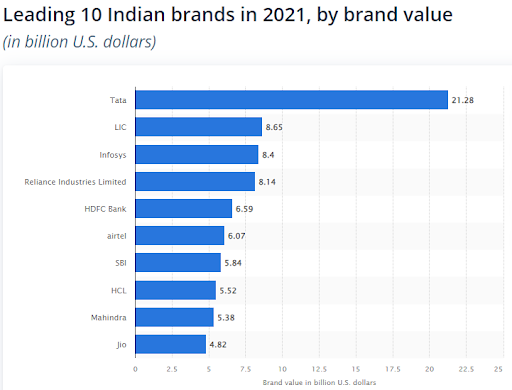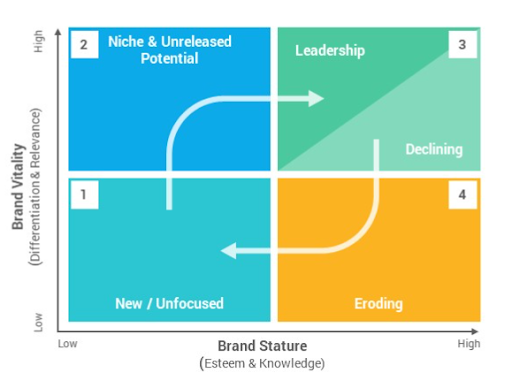Brand Asset Valuator Model: What It Is And How Is It Evaluated

Brands are built; they just do not happen. Not just according to today’s market scenario, but from ages ago, any product or service are needed to be branded and marketed to make it successful and profitable. Entrepreneurs now are truly aware of that need and strategically plan the brand building for a sound market value. Getting market recognition, loyal customers, and winning over all the competitors needs effort and a mixture of various strategies. Unfortunately, despite studying the market conditions and making master plans, businesses fail to achieve the desired results due to the highly volatile circumstances. And companies start adopting trial and error methods, which may have any positive or negative effects. To overcome this situation, marketers implement the brand asset valuator model as it helps them measure the strengths and growth potential of brands.
Making a brand needs effort and money, which most businesses put in, but ignore brand asset valuator, and that becomes one of the reasons for not reaching that position. Are you aware of the brand asset valuator model? What determines it, and the other concepts connected to it? If not, then to completely understand the brand asset valuator model (BAV), read this article till the end.
What Is Brand Asset Valuator Model
Brand asset valuator computes the brand value of any business. This model was evolved by Young & Rubicam, an American marketing and advertising agency. This agency has surveyed for around thirteen thousand brands, including thousand consumers from thirty-two different countries. A brands’ growth potential can be determined by the asset valuator model. The result is obtained on the basis of four main aspects differentiation, relevance, esteem, and knowledge. It shows the result metrics of how appropriately the business has marketed till now. In short, by collecting consumer preferences, BAV displays the position of any business, where it stands in the market, and the value it holds, whether it is a product or service.
One of the critical observations on brand value was that it appears or turns out only when the business has passed sufficient time. It can be a most powerful tool for business valuation if the business owners are mindful of it and use it. Then, the impacts of marketing strategies and different branding activities of the companies will be revealed. The buyer should recognize and choose the thing that a business sells over the other options available to come out as a famous brand. Look at the example, if you sell instant noodles, consumers wanting it should know about it and should be in their reach otherwise, they will always prefer buying Maggi noodles which have already established themselves as a big brand. The below image displayed the 10 leading brands of India in 2021.

2 Major Dimensions Of Brand Asset Valuator Model (BAV Model)
The four determinants of the brand asset valuator model can be categorized into two major dimensions: brand vitality and brand stature. Let’s look at it in detail:
Brand vitality
Brand Vitality = Differentiation + Relevance = Brand Strength
Brand vitality includes two determinants, differentiation, and relevance, which come out as brand strength. It is the future potential, which comes only when the product is unique and relevant to the customer.
Differentiation- shows the differentiation level between your service and the product with others delivering the same. The first and foremost thing any brand has to develop is a distinction from all the existing providers in the market. Consumers will be questioned regarding the brand, and their attention will be observed, whether they are able to recognize it, if yes then how they differentiate it from others. Any business will fade and never grow if it does not have any differentiation.
Relevance- shows whether your deliverables, which can be either a product, a service, or both, are able to connect with customers’ demand. People have their preferences according to the price and their convenience. Does your business provide customers with what exactly they want and meet their expectations? The market penetration also affects relevancy and differentiation.
Brand Stature
Brand Stature = Esteem + Knowledge = Brand Performance
Brand stature includes esteem and knowledge, which shows the current condition and position of any commodity and service. It can also be an indicator of the brands’ past performance and future scope.
Esteem- shows the perceived quality and popularity of any brand as per the selection and preferences of the users. This one traces whether the brand keeps up with its quality and gives the same assurance while taking different actions. Nowadays, to capture popularity and increase brand visibility, social media marketing, SEO, and content marketing are practiced mainly by businesses. But again, popularity and quality determine up to what level the consumer holds on the brand.
Knowledge- This is the state where all the brands want to stand. Knowledge here means that the market and users are highly aware of the givings and are able to identify and differentiate them quickly. When the stage of differentiation and relevancy is cleared, it results in high esteem. Combining, all the buyers get the required knowledge, making any business a famous brand.
Evaluation : The Power Grid Of Brand Asset Valuator Model
A comparative view of the strengths and the flaws will be obtained by the power grid. That can moreover be termed as the pillar patterns as it depicts the collective results of all four determinants. The grid view helps clarify what impact the strategies applied are creating and which are needed to be replaced. The brand progress cycle can be supervised to keep it moving ahead. As the below picture shows, the grid has four quadrants, brand vitality stands on the vertical axis, and the horizontal one shows brand stature. Each quadrant is described below:

Image(Slide Salad)
New/ Unfocused
As it is self-explanatory, ‘new’ brands that are just launched fall under this quadrant. Lower brand vitality and stature and the users do not focus on the product as it is unknown. The business tries to raise attention and awareness amongst the users at this stage.
Niche/ Unrealised
The new businesses that managed to gain some differentiation and awareness reach this quadrant. Therefore, the product or service gains momentum and builds differentiation, esteem, and knowledge. It is the depiction of the brand’s potential in the specific market niche. However, reaching the leadership quadrant is not easy as the brand stature is proportionally low.
Leadership/ Declining
The ideal position where all the businesses want to reach and stay. Existing leading brands are in this position, having high vitality along with stature, which brings bigger revenue. This quadrant is diagonally divided, and the other part shows the declining brands. Companies that fail against making the required changes and not upgrade their strategy will decline.
Eroding
The firms that fall in this quadrant give complete knowledge about their offering to the customers, but the relevance and esteem are very low. The target audience has the information about the product, but it does not satisfy them according to their needs and choose over the substitutes available. Thus, the brand gets old and again tries to attain its position in the market by entering the first quadrant.
Connecting The Dots Of Business Concepts
As the article also states above, the brands are built with the collective impact of all the strategies and the marketing mix. So here are some of the related business concepts that need equal attention in making a business accomplished and profitable.
The Essence Of A Brand
Every brand has its unique essence, which makes them stand out. A successful business offers its product or service with such features that no one in the market gives. The essence of a brand makes the customers emotionally attached where they cannot easily switch over to others brands. Brands try to fit in with the customers’ habits to create a loyal customer base. Having a unique selling property is vital for sustaining the market.
The Brand Positioning And Equality
Brand positioning is having the brand’s place in the customer’s mind constantly. The positioning can be based on lifestyle, values, or any other way. When a buyer has a clear idea of what they have to choose, then that brands enjoy the vast and loyal customer base. Brand equality comes when the customer willingly pays the premium price when different alternatives are available due to the difference in perception.
Summary
Building powerful brands that make a long-lasting impact on the people is not simple and trouble-free otherwise, each product made or any kind of service business started would be a big brand. Constant efforts and walking along with the market and consumer perceptions and preferences will help attain a certain position. The brand asset valuator model aids the process of building and developing the brand. Reading this article will give you a better idea of what BAV is, its dimensions, and related business concepts.




